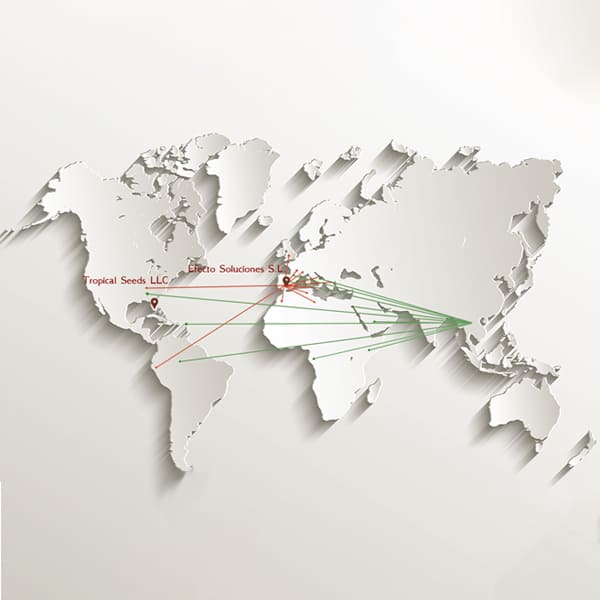Orium
Veza Villosa
Orium (Veza Villosa) belongs to the family of legumes, autumn winter – spring cycle. Orium stands out for its fine stem and its high biomass production capacity. It also stands out for its low water need, adaptation to climates with low temperatures and high altitude areas. In its morphology it presents brambles which makes it a plant that can grow climbing when it is planted accompanied by another species that serves as a tutor.
Orium is produced under strict protocols with which we obtain a high quality of seed in reference to varietal purity and germination.
Due to its characteristic Orium can be used as fodder or as green manure
Productive and versatile
Characteristics
- It is a vetch (annual legume) that stands out for its ability to adapt to all types of soil and its high production.
- It is very rustic and has great behavior with different problems of more common diseases of the veza.
- It has a deep root system, branched and provided with nodules in which live in symbiosis bacteria fixing atmospheric nitrogen, climbing stems, paripinnate leaves terminated in a branched zarzillo, red-violet flowers, fruits in legume.
-
Production: 8 Tn/Ms/Ha
Use of green manure
- Increases soil fertility
- Increased biodiversity
- Soil erosion control
- Improves the physical, chemical and microbiological conditions of the soil
- Nitrogen fixation
- Benefits of crop rotation
Forage use
- Major productions
- Various uses: hay, silage and grazing.
- Excellent protein percentages
- Fine stems
- Adaptation to use with other species



Sheet
Scientific name of the species
Veza Villosa
Common name of the species
Orium
Vegetative cycle
Annual
Growth
Erect
Height
Up to 1 mtr
Growing season
Autumn - winter
Diffusion
Seeds
Soils
Deep, well drained. Sandy, silty and loamy loam
Drought tolerance
Very high
Frost tolerance
Very high
Salinity tolerance
Stocking
Flood tolerance
Casualty
Total dry matter production/ ha
7,000 - 8,000 kg of dry matter / ha
Palatability
Excellent
Toxicity
No
Planting period
From the beginning of autumn
Planting density
50 - 80 kg/ha
Depth of planting
1-2cm
Remarks
Use as cover crops and forage production
Implementation of Orium
Preparation of the land
Sowing and establishment
Data to take into account is the planting surface, the correct surface is 1 cm. deep in the ground.
- The use of compactor curl in sandy soils improves the quality of planting based on the uniform acceleration of seed germination (not recommended for clay soils).
- It can be sown in direct sowing obtaining excellent results.
The optimum temperature of development is between 15 and 20ºC, causing damage to the aerial part with temperatures below -5ºC.
Water needs
Crop adapted to areas with rainfall between 325 and 600 mm. It does not have a high resistance to waterlogging.
Uses
Forage
It has been commonly used for cattle feed both in green, silage and henified. This last form of use is the traditional one due to the specific climatic conditions that occur in many producing areas. It is the most used system, with 95% of the production going green. Another destination of green production can be dehydration, which is taking more and more weight.
Green manure
It consists of the burial of plants in green. This increases the organic matter and thanks to its power of nitrogen fixation we increase its parameter in the soil, as well as its fertility in general.
Fertilization
The veza being a legume has the characteristic of supplying nitrogen through the phenomenon of symbiosis that stable with bacteria of the genus Rhizobium at the root. This will provide much of the nitrogen you need and therefore your needs will be much lower than those of other crops.
However, in the early stages of the crop, the legume-bacteria complex will not be active so it is advisable to apply 15 to 20 kg N / ha in sowing to favor the establishment in the phase prior to nodulation. As for phosphorus and potassium, fertilizers of the order of 30 to 40 kg of P2O5 and
from 35 to 50 kg of K2O.
Diseases
Videos

Contact us
- Responsible: Efecto Soluciones S.L.
- Purpose of the collection and processing of personal data: to manage the request you make in this contact form.
- Rights: You can exercise your rights of access, rectification, limitation and deletion of the data in info@efectosoluciones.com, as well as the right to file a claim with a control authority.
- Additional information: In the privacy policy you will find additional information about the collection and use of your personal information. Including information on access, preservation, rectification, deletion, security and other topics.

